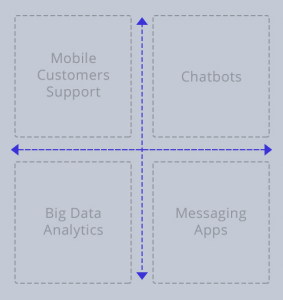Technology is often seen by marketing as a disruptor of business as usual, but it isn’t. Technology is an enabler of a customer-first strategy, at least when used properly and appropriately. So what is disrupting business as usual? It’s the customer, especially in industries that are not customer-centric.

Executive Director JP Morgan
It was
I had already been speaking about the need for businesses to prepare for the dramatic change that was coming thanks to technological innovation. However, it was Pacheco’s slide that made me realise why I was so keen on companies adopting a customer-first strategy and running scenario planning.
His five simple examples brought it home more powerfully than I have ever done before. That’s why I wanted to share it with you. The summary says:
- Netflix did not kill Blockbuster, ridiculous late fees did.
- Uber did not kill the taxi business, limited taxi access and fare control did.
- Apple did not kill the music industry, being forced to buy full-length albums did.
- Amazon did not kill other retailers, bad customer service did.
- Airbnb isn’t killing the hotel industry, limited availability and pricing options are.
In conclusion it states that:
“Technology by itself is not the real disruptor. Not being customer-centric is the biggest threat to any business.”
That’s music to my ears!
Looking again at the five examples he gives, there are a number of specific aspects of customer-centricity that are highlighted. In my opinion they show the following advantages for the customer:
- freedom of choice
- transparency
- trust
- being valued
If you don’t want to see your own industry fall victim to start-ups that better provide these, then now is the time to act. Or rather if you’re not already on your journey to adopting a customer-first strategy, you’re probably already seeing a slowing, if not actual decline, in your growth and profitability.
The Future of Many Industries is Unthinkable
By this I mean that change is happening so fast that it is difficult for organisations to even imagine the future. This is why I encourage my clients to develop plausible future scenarios, rather than merely follow trends. Only by doing so, can they be prepared for every possible risk and opportunity. Identifying one, most likely future is unlikely to deliver the variation that will no doubt happen. For more on this topic, read “5 Business Success Factors (So You’re Ready for Anything!)”
As I mentioned at the beginning, technology is an enabler that permits industries to provide more of what their customers want. There are already many examples of ones which have been helped or radically altered by technology and science. For example:
 TELECOMS now make as much money from selling (geo-localisation) data than they ever did from selling phones and lines.
TELECOMS now make as much money from selling (geo-localisation) data than they ever did from selling phones and lines.
Already back in 2015, data accounted for 44% of Verizon’s profits, as shown in this Adage article.
Don’t you think their business model changed – dramatically – as a result of this? Of course it did!
In the 2015/17 period the Verizon group bought both AOL and Yahoo’s internet business. This was further proof of their prioritisation of data usage as they tried to access the digital advertising market quickly. But they made several mistakes.
These were both later sold in 2021 as part of their media group disposal, although they did retain a 10% share. During this five-year period, while their revenue has remained stable, their share price rose 25% confirming support of their new business model.
FOOD companies are shifting from machine-made to do-it-yourself meal-kits. In fact, to be precise, the industry is being ever-more disrupted by start-ups offering replacements to the mass-produced, less-than-healthy products that Nestle, Mondelez, Kraft Heinz and Danone have been churning out for decades.
Companies like Blue Apron, Green Chef, HelloFresh, Martha & Marley Spoon, Plated, and Sun Basket all offer healthier and fresher alternatives.
In response to their challenge, the largest food manufacturers are trying to compete by lowering “bad” ingredients and increasing “good” ingredients in their mass-produced brands. However, take a look at what they are doing in detail and you will see that in most cases their “improved” products are no better for us. They still have far too much sugar, salt and trans fats, despite being reduced. They also still lack fresh ingredients, which we all know are far better for nourishing a living body.
[signinlocker id=”25973″]
BEVERAGES manufacturers are getting into entertainment in a big way. They have always sponsored or promoted events, bars and cafes. Coca-Cola is probably the best known for this with sponsorships including American Idol, Apple iTunes, BET Network, NASCAR, NBA, NCAA, and the Olympic Games.
But some drinks manufacturers are going much further and have now started including media development too. As a great example, think about Red Bull which today is seen more as an entertainment company that just happens to make a drink!
TOBACCO AND CIGARETTE manufacturers have been fighting to protect, even save, their industry for decades. Andre Calantzopoulos, the former CEO of Philip Morris International, declared in a Radio 4 interview a few years ago that
“I believe there will come a moment in time where I would say we have sufficient adoption of these alternative products … to start envisaging, together with governments, a phase-out period for cigarettes.”
Coming from one of the largest global cigarette manufacturers, this is huge! But he is (hopefully) right. The future of the tobacco business is in heating rather than burning it, at least short term. Longer term I believe they need to look to other ways of providing personal pleasure that does less harm to the user and to their environment.
PHARMACEUTICALS have for years been moving investment from sickness to wellness and health. An excellent article on the topic mentions that:
“The transition from current ‘high-risk, high-margin’ business model to ‘low cost high volume’ nutria business model is dependent on many factors and also advised to move into less regulated markets like animal and consumer health.”
The line between Food and Pharma is blurring as companies expand and invest in the “other side” of nutraceuticals.
Which will win out in the long run? Your guess is as good as mine, but I’d love to hear your thoughts in the comments below.
TRANSPORT. Will there even be a viable automobile business in the future? How many manufacturers will survive as the market for personalised road transport collapses?
As people move from ownership to rental, and from self-drive to driven, the industry will need to move into alternative modes of transport to make up the shortfall in their businesses. What do you think?
McKinsey wrote a great analysis of the future of the industry that is worth a read. It summarises the opportunities and challenges as:
- Focussing on digital, with digital sales offering contactless test-drives, and car home deliveries, that proved effective during the covid shutdown for one Chinese car manufacturer.
- A shift to recurring revenue streams, since before covid, 34% of Generation Y consumers expressed a preference for rental and ridesharing products, showing how recurring revenue streams could become very important to automotive players.
- Optimize asset deployment through strategic partnerships, as rapidly growing and hugely inventive tech players—from EV (Electric vehicles) makers to autonomous vehicle (AV) innovators challenge the slower-moving traditional automobile industry.
- Embrace zero-based income statements, since the pandemic has devastated the auto-industry growth, which showed a 15% decline in 2020. This will catalyze much-needed changes such as the consolidation of production facilities, the elimination of low value-added activities and the reduction of investments in noncritical new assets.
- Build resilience into the supply chain by using data and analytics-driven demand and supply-chain transparency, which will result in new, faster processes and more agile practices.
- Establish a strong decision-making cadence which should include faster decision-making, execution discipline and clear accountability.
Although these came from an analysis of the automobile industry, I think that most of them apply to mostl industries going forward, don’t you?
Harnessing technology to enable companies to adopt a customer-first strategy
A 2016 Forrester report shows that while 72% of businesses say improving customer experience is their top priority, only 63% of marketers prioritize implementing technology investments that will help them reach this goal!
It therefore makes sense that I include in this post some of the best examples I have found to start you thinking about your own situation. (If you want to know just how good your customer-first strategy is, click the button below to find out.)
 How are you harnessing technology to provide your customers with greater freedom of choice, trust, transparency and the demonstration that you value their business and loyalty? Here are some inspiring examples and ideas:
How are you harnessing technology to provide your customers with greater freedom of choice, trust, transparency and the demonstration that you value their business and loyalty? Here are some inspiring examples and ideas:
- Amazon uses technology to identify suggested products to their clients. Many others have followed this great example and we are now bombarded with “people like you also bought…” proposals. Like it or loath it, they do come in useful occasionally, don’t they? It also shows that the company is using your data for your good and not theirs (alone).
- Your websites can provide your customers with a wealth of information. It can also provide a platform for them to share their tips, ideas and associated facts which would be useful to other users, as well as ask questions. Petcare, Personal Care and Homecare br>ands make use of this in particular. Check out P&G and Mars Petcare for a couple of the best.
- Insight development today uses more than information from market research. Therefore technology is used to enable quicker and deeper integration and analysis of all the information flowing into an organisation. Machine learning adds further value by understanding the relationships between the data which may have previously gone unnoticed. Many of the global CPG companies are going this, including Unilever and Coca-Cola.
- Social Media has become the new customer services department because replies are almost instantaneous. Pizza Hut is a great example of this, answering any customer complaints in record time. Other brands react more slowly and then feel the wrath of their customers who are today expecting immediate answers to their questions. Make sure that’s what you offer!
- Chatbots are providing additional resources to the already overworked customer services departments. Findings from recent research in the UK show that many high street brands offering live chat and chatbot technology consistently performed better in customer sentiment analysis.
[/signinlocker]
These are all examples of ways that are already being used so you can benefit from the experiences of others. But the world is moving fast and you need to also be exploring further new territories where technology can help.
Earlier this year ZDNet highlighted five technologies that touched on technological changes that could impact customer service and experience. They were:
1. Two-way video

2. Augmented and virtual reality
3. Virtual assistants
4. Messaging
5. Connected devices
As you can see, all five technologies are enablers of improved customer satisfaction, which will lead to increased relationship building and trust. Customers view them as novel and useful today, but it won’t be too long before they are seen as the norm. Are you using them? If so, what experiences have you had, as I’d love to hear more about their uses?
Another recent article, this time on Jacada, spoke about the “4 Technology Trends set to Improve Customer Experience in 2017.” (See their diagram on the right) In it they highlighted ChatBots, Big Data analytics, Mobile customer support and messaging Apps.
In this article they pulled out the larger areas around how technology can help with mass connection and analysis of the resulting exchanges.
What both these articles highlight is the need for marketing to harness technology in order to build relationships with their customers. If they do so, they can set their brands apart from the competition. If you are not already doing so, then you have little time remaining to catch up before being left seriously behind.
It conclusion, it is clear that technology is an enabler and can and should be employed to improve the customers’ experience. We live in a fast-paced world where we expect instantaneous responses from brands, and information at our fingertips where and when we need it. Technology is the only way we can meet these increased customer demands, by collecting, analysing and then actioning the learnings from these contacts.
Which of these are you working with today? I’d love you to share your experiences – good and bad – below.













